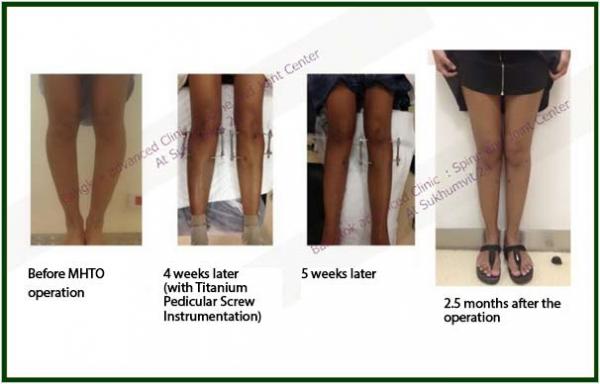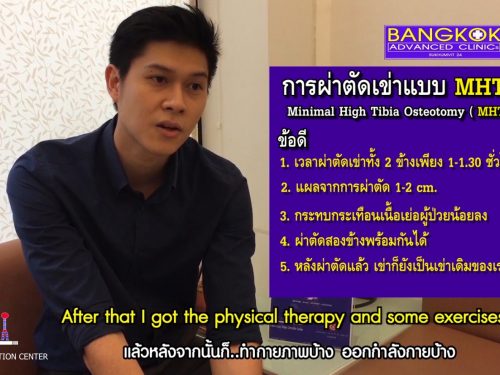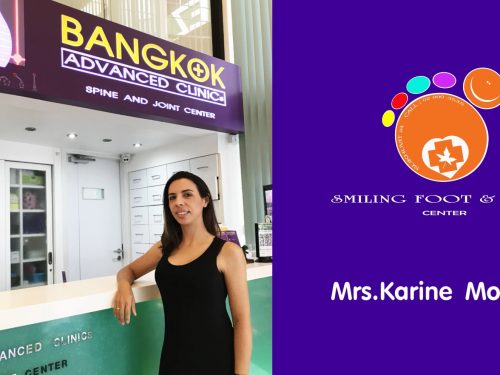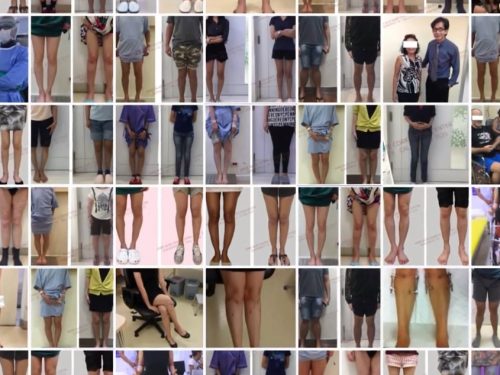
“The treatment for varus knee (bow-legged) correction”
Nowadays, there are only three standard treatments for varus knee correction to regain straight knees, which are acceptable for successful result.
1. Knee replacement
This technique is suitable for inactive patients (older that 65 years old) with severe osteoarthritis of the knee. They currently receive full alternative
reatment though the pain has not improved still. Knee Arthroplastydoes not really last forever since it can only be used and worn for an average of 10-15 years. Patients need to use it carefully, avoiding contact sports. Otherwise, it has to be replaced earlier than expected. Another major disadvantage of knee replacement is having catastrophic infections. Knee replacement is only reserved for elderly patients with severe stage of knee osteoarthritis since it is the last option left.

2. Active Training of Quadriceps Muscles
During normal walking, the quadriceps muscle should relax and transfer load of body weight to the patella and foot so the load transfer to the knee cartilage decreases. If the patients have weak quadriceps muscles, the load has to transfer to the knees. The knees cannot bear the body weight ; the instability can occur while walking until the knees become progressively bowed. General populations have 5,000-8,000 steps of walking per day. The force can erode knee cartilage slowly so it is very important for patients to strengthen their quadriceps muscles. Each exercise has different benefits such as running ; it is good for the heart and lungs but the knee can deteriorate too early. The exercise that is good for the knee is the active training of quadriceps muscles, which makes the muscles stronger without load transfer to the knee cartilage. We will give you more details on active training of quadriceps muscles later on but we would like to stress that exercise is very important for every patient, and in every age especially in orthopedic patients.
In the aspect of this treatment, the leg can become straighter, particularly in patients with weak quadriceps muscles and slightly bowed leg. This treatment can be an additional treatment for post-operative treatment to improve better, and for a faster recovery.

3. High Tibial Osteotomy (HTO)
This operation is medically accepted worldwide and can achieve good results. It is proper for bowlegged patients (ages 18-65 years old) and those who desire having an active lifestyle. They can bend normally and join all sports because it is our real straight knee that can tolerate the load, but not the artificial knee. It is the operation that corrects the exact problem of the knee.

There are many advantages for HTO:
- The operation does not get into the knee joint, so it is less likely to be infected.
- It is the natural knee, not the artificial knee.
- The cartilage of the knee is not removed, but the knee is realigned to become straight knee.
- The load that transfers to the knee is shifted to the lateral side of the knee, which is the healthier side; the load on the medial side of the knee is decreased and the cartilage on this side can regenerate.
- Total knee replacement can be delayed or avoided after HTO.
There are three techniques for fixation in HTO:
1.1. HTO with long leg cast immobilization
After the osteotomy and varus correction, the leg is immobilized in a longleg cast for 2 to 3 months. This cast has a disadvantage since we have to put it on the whole leg ; the patient cannot bend the knees for a few months so there is quadriceps muscle atrophy around the legs making it a bit smaller, that’s why this method is not that popular.

1.2. HTO with internal fixator application
After the varus osteotomy and correction, the leg is fixed with internal fixation (Titanium Pedicular screw), with the advantage of not having any instrument installed on the surface of skin. But there are some drawbacks, too: the patients must have longer incision, and the fixation stays inside the patient’s body forever. Some patients may want to remove it so they need to undergo another operation.

1.3. HTO with external fixator application
In this technique, we cut the bone in the upper part of the leg and realign the leg in a normal alignment by fixing it with two pins. The pins are assembled with two rods. They stay outside the skin for six weeks. The great advantage is that we can adjust the alignment post-operatively. After the bone heals, we can totally remove this instrumentation. The only inconvenience, on some patients, is having skin irritation until removal of fixation.



The bowlegs without any pain have no need for any treatment. However, treatment can be further discussed if patients find their leg appearance unsatisfactory or they are not that confident to wear short pants, skirts, or skin-tight jeans.
Example of the patients that have the operation to correct bowlegs, using MHTO techniques on the two legs at the same time.
Note : Actual photos (Credit to our patients)





Actual photos (Credit to our patients)

RELATED ARTICLES
The Drawback of having bowlegs Part 1
When do you need surgery for bowlegs? Part 2
Varus knee (bow-legged) correction in young adults Part 3
Types of Bowlegs and Operation Methods to Cure Part 4
The operation to correct bowlegs, knock-knees Part 5



